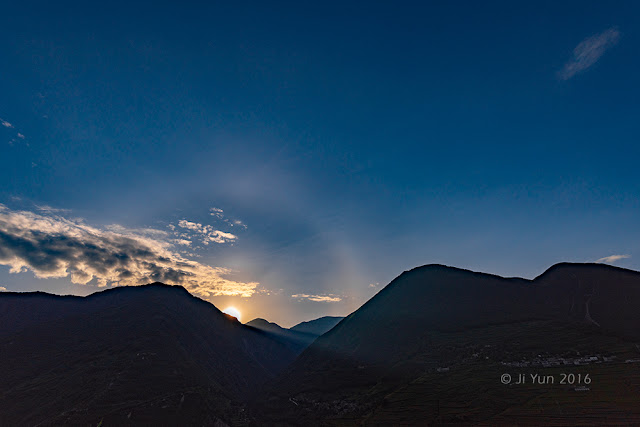Odd radius column arcs have long been deemed as some of the rarest halo forms. Sighting reports in most parts of the world have indeed been sparse. However, during the past few years in China, we came across a good number of odd radius column displays. Spring monsoon seems to bring them to our country every year.
In 2018 we documented at least a dozen such displays country wide, most of which occurred in April and May over Southern China. Here I’d like to share with the world some of the most noteworthy ones. All photos below are single shots with only minor USM applied.
On April 29, photographer Cui Yongjiang witnessed a long lasting display from Shangri-la, Yunnan Province. Complexity of the display peaked in the afternoon when the sun dropped to around 40° altitude. The 9° and 24° column arcs in this display are rather weak, implying short prism faces among the crystals.
 |
| © Cui Yongjiang, shown with permission |
Later on May 17 in Sanya, Hainan Province, Weibu captured a short-lived display in which the sun sit at 83° altitude. At such high altitude, most odd radius column arcs turn into circles. The 20° and 35° column arcs have their upper half much brighter than the lower half. The way that the 20° column arc completely outshines other arcs in this display is quite interesting. Crystals with long pyramidal caps and very short prisms might have been responsible for such appearance.
 |
| © Weibu, shown with permission |
Up until August, all documented column displays took place in Southern China. Such displays have been much rarer in Northern China where monsoon from the Indian Ocean hardly reaches.
The pattern does get busted sometimes. On August 12, the best display of the year swept across Heilongjiang Province in Northern China. Middle school teacher Mao Xiufang from Daqing noticed this complex display during class break and snapped this amazing shot with her phone. The 20° column arcs in the display are sharp while the 35° column arcs are vividly colored. The 9° column arcs are even displaying their theoretical curly-bracket shapes.
 |
| © Mao Xiufang, shown with permission |
An hour later, the clouds advanced 200km east with crystals reaching their peak diversity and optical quality. Fang Tongbing grabbed this handphone photo manifesting the display at its best. The sharpness of the 9° , 20° and 24° column arcs are very close to simulations. Had the crystal quality been any better, we might even start seeing traces of odd radius Parry arcs!
Apart from the column arcs, some plate orientated crystals also joined the party contributing to a weak 23° upper plate arc.
 |
| © Fang Tongbing, shown with permission |
This high quality display turned out to be the last odd radius column display from China in 2018. Overall we had a big year for odd radius halos. Interestingly all these displays occurred close to noon hours when the sun was higher than 40°. The cause of this pattern could be a meteorological subject worth studying.
Hopefully in the year of 2019 we will be blessed with more displays like these. Stay tuned.
Jia Hao




































